Key insights
- Japan’s demographic development means that labor shortages are acute across all sectors.
- After decades of slow growth, wages in Japan are now rising much faster than before the pandemic.
- The number of foreign workers is rising but not fast enough to compensate for the shrinking workforce.
- Robotization and technological progress are Japan’s (and Europe’s) best bet to solve the problem of missing workers.
Japan – the land of low wage growth
Paul Krugman was right when he once proclaimed that Japan’s economic experience might be a precursor of things to come for other advanced economies.
Following the infamous burst of its asset price bubbles in 1991, Japan’s economy slipped into recession. The economy also experienced moderate deflation for many years, even as the Bank of Japan (BoJ) cut to stimulate the economy by printing money.
However, Japan’s two-decade long experience of low inflation has now ended with inflation recently surging to close to 3% for the first time since the early 1990s. Long-stagnating nominal wages have finally begun seeing some sizable gains since the beginning of the COVID pandemic with salaries growing by 4% recently.
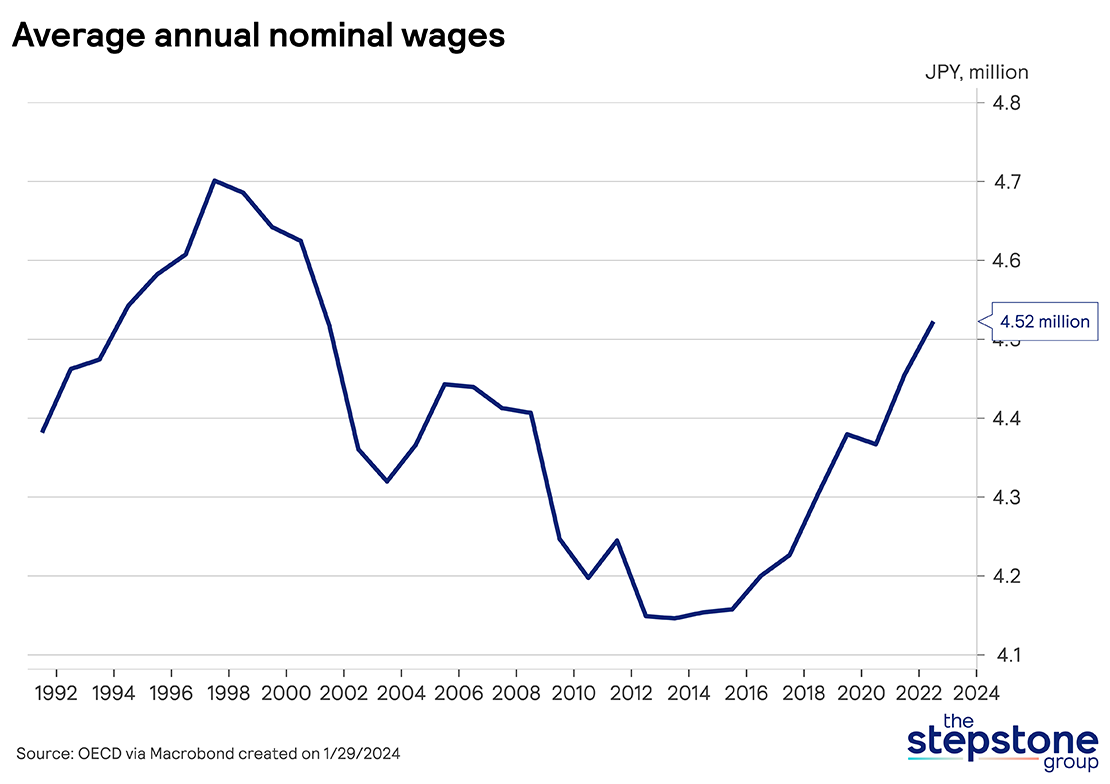
Japanese demographics are among the worst in the world
For structural and institutional reasons, Japan has always had a very low unemployment rate. During economic downturns, companies and managers are wary of laying off workers. The unemployment rate ticked up only slightly even during the COVID lockdowns.
Demographic factors have clearly played a role as well. As we wrote last year on Recruitonomics, Japan is ground zero for what we call full employment recessions, an economic contraction combined with a tight labor market. While this phenomenon now affects Europe as well, it struck first in Japan.
The Japanese working-age population peaked in the early 1990s and has been contracting ever since. Japan’s tight labor market can be traced back to a scarcity of prime-age workers.
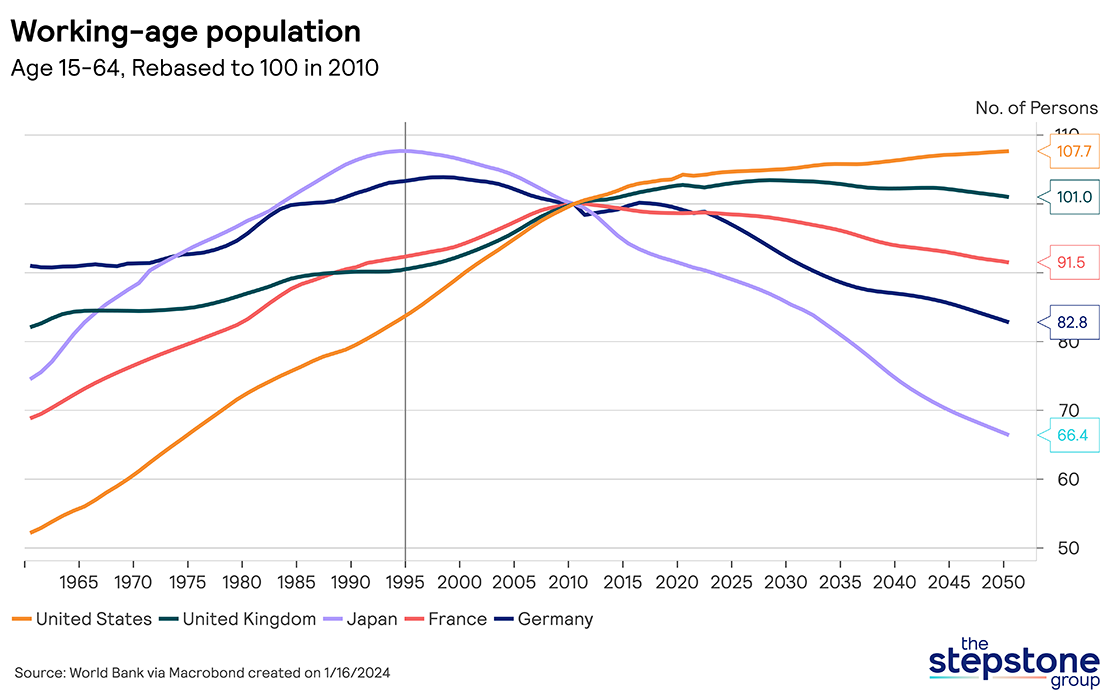
As a result of the shrinking workforce, an increasing number of employers in Japan are reporting that they have an insufficient workforce. The Tankan survey conducted by the BoJ shows that this is a trend that has become increasingly severe since the 2010s.
It is especially nonmanufacturing jobs, employers in the service sector, who have difficulties maintaining sufficient employment – as indicated by negative values in the chart.
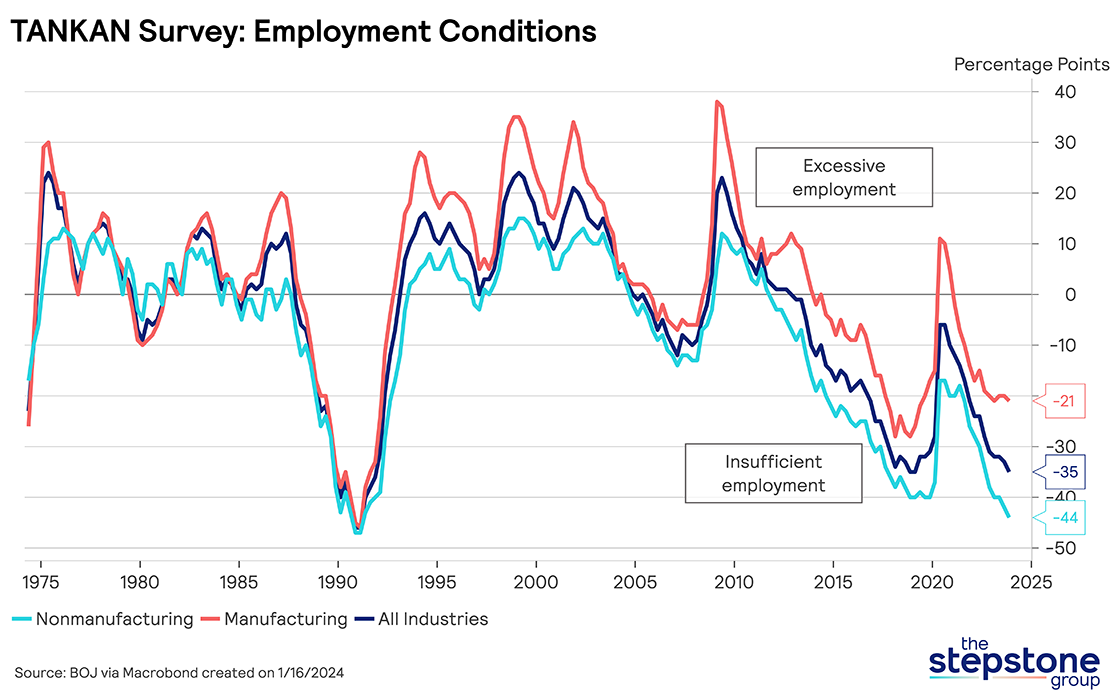
While the total number of vacancies has not reached its pre-pandemic peak quite yet, the labor market is clearly much tighter than historically normal. The job-openings-to-applicant ratio is currently standing at 1.3, significantly higher than in the 2000s and early 2010s.
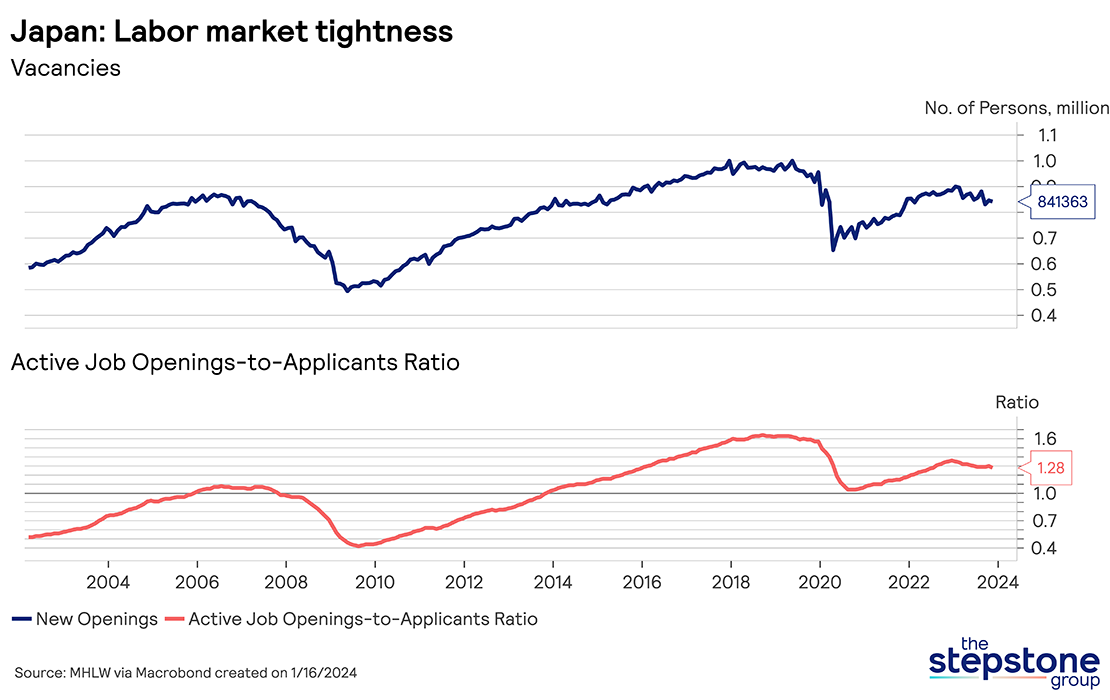
Total employment has still been increasing slightly over the last decade, but this is mostly the result of older workers staying in the labor force for longer. Employment of people aged 65 and above has doubled from about 4.5 million in 1995 to more than 9 million today!

Many businesses were somewhat wary at first that hiring older workers increases their costs – older workers are more prone to on-the-job accidents and employers need to work harder to ensure their safety.
However, an article in Nikkei Asia reports that about 40% of businesses now accept employing workers aged 70 and above. This number has doubled over the last decade. The share of older workers is highest in industries facing serious labor crunches: 15% for construction and nursing care and more than 10% for transportation. About 30% of taxi and bus drivers in the transportation sector are 65 or older.
Global labor market conditions are changing
In the past, global offshoring to China could make up for the tight labor market conditions in Japan. The global labor supply surged when the Chinese economy and the former countries of the Soviet Union opened up to the rest of world in the 1990s. Many global corporations in the West, including Japan, started to offshore their manufacturing processes to utilize the cheap labor that the Chinese economy provided.
However, China is currently suffering from a large economic downturn paired with adverse population impacts of the one-child policy. Moreover, the political conflict with the West has intensified and many global corporations are currently trying to decouple from China to de-risk their supply chains. Nearshoring to Mexico, for example, has become the new thing.
For Japan, this means that offshoring to China is becoming riskier as well. Unfortunately, all advanced economies are currently experiencing much tighter labor markets than before the pandemic.
This means that Japanese companies no longer have the advantage of abundant labor abroad. More migration could potentially provide some relief, but Japan is known for being a low-migration country.
Nevertheless, the number of foreign workers in Japan has more than tripled since 2010 from about half a million to about 1.8 million in 2022. While this is unable to make up for Japan’s shrinking working population, it is a step in the right direction.
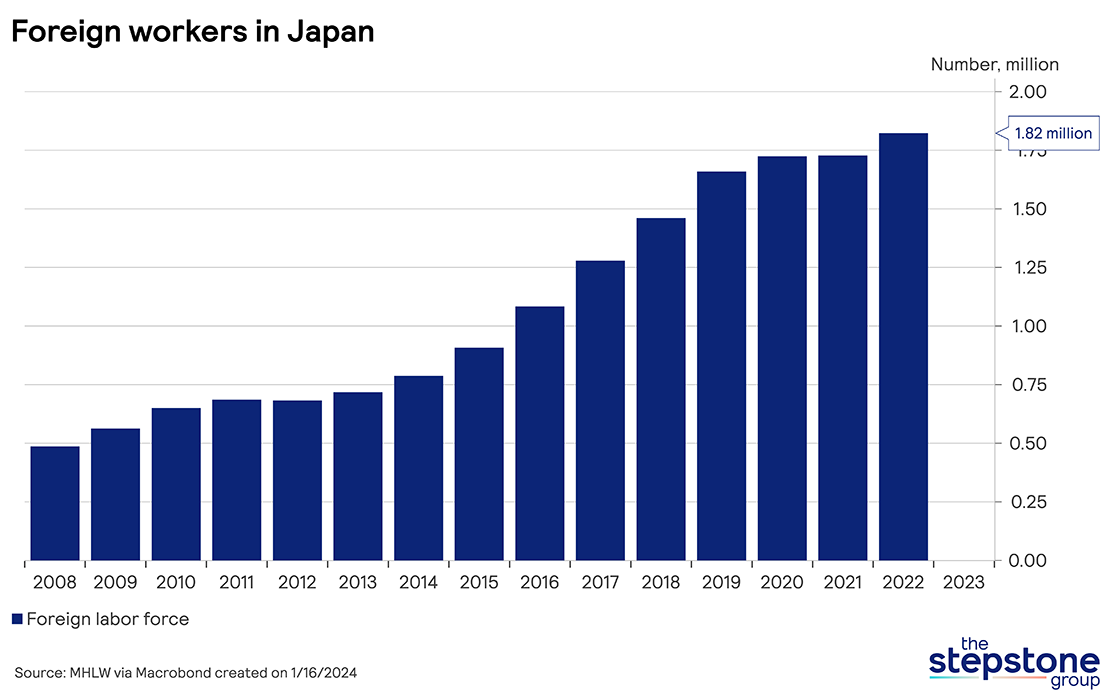
What does that mean for the labor market of tomorrow?
Even Japan – the country with nominal wage growth of zero for many years – is now seeing an acceleration in wages. While demographic factors have been a pain point for the Japanese labor market for a very long time, an abundance of cheap labor in China and elsewhere was previously able to offset this demographic pressure.
However, there is now a reversal when it comes to offshoring. Moreover, all advanced are currently experiencing a synchronized tightness of labor market conditions. And for that reason, Japan’s economy is now feeling the pressure as well.
While the central bank can always put a lid on rising wages, it is not clear whether this is desirable since it might require an economic downturn.
Japan is a clear example of how adverse demographics are now causing a shortage of workers across all sectors. Migration can provide some partial relief. However, as the overall labor supply stagnates or even shrinks across advanced economies, technological change and higher productivity growth will have to make up for the lack of workers. As I have argued in a Macro Hive piece, the incentive to swap workers for robots is increasing as wages are rising faster than before the pandemic. Maybe the high wage growth of today will lead to faster technological change tomorrow?
The rise of the (service) robot
There have been signs for years that this is already happening. Seven out of the ten world’s leading industrial robotics companies are located in Japan. The country is also one of the most robotized economies in the world.
Being one of the leaders in industrial robotics adoption to reduce the burden of manual work, there is now a clear push in Japan to use robots for everyday life. The intention is for service robots to become an integral part of Japanese households, given that they are already being employed and thriving in healthcare, nursing homes, and retail. Several Japanese companies, including startups, are currently working on designing service robots for everyday life.
What can Germany and other countries learn from Japan?
Countries like Germany are just one decade behind Japan in terms of the demographic outlook. As the working age population has already begun to stagnate or even shrink, Germany will have to follow in Japan’s footsteps to reduce the economic costs of an acute worker shortage.
First, there needs to be a greater acceptance of older workers. Japan has been leading the way in integrating more workers aged 70 and over into the workforce out of sheer necessity. As life expectancies increase, such a step is not only desirable from an economic but also from a social point of view. Not everyone enjoys full retirement and some people of higher age actually desire being part of the workforce, at least part time.
Second, other advanced economies would do well to follow Japan and roboticize as quickly as possible. The push of replacing scarce workers with machines makes sense for many manual tasks. Not only would this lead to labor being better utilized, but it also would lead to workers being able to do more meaningful tasks and jobs. Finally, it could also increase economic growth, which would benefit workers in the long run via higher wages.